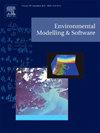Development of an inclusive, scalable, and flexible hydrologic modeling system: Establishing integrated flood simulation system at agricultural watersheds
IF 4.8
2区 环境科学与生态学
Q1 COMPUTER SCIENCE, INTERDISCIPLINARY APPLICATIONS
引用次数: 0
Abstract
In this study, we developed a comprehensive hydrological modeling system to address the diverse needs of hydrologists and researchers. The system comprised nine modules, each serving a specific purpose. These modules include a multiplicative random cascade model, frequency analysis, inflow simulation, Hydrologic Engineering Center – 5, Hydrologic Engineering Center – River Analysis System, and farmland drainage simulations. The system follows a structured sequence within a large framework, beginning with user inputs for the initial condition information and period specifications for frequency analysis. It then calculates the time-disaggregated precipitation data utilizing the Dask distributed server for efficient computation. Subsequent module computations were conducted on dedicated mask workers. The Integrated Database serves as a comprehensive repository for simulation studies, encompassing historical precipitation data, shared socioeconomic pathways, climate change scenario data, and reservoir and farmland survey data. This system has been used in several studies and has provided cohesive and reliable results for flood simulations.
开发具有包容性、可扩展性和灵活性的水文建模系统:建立农业流域综合洪水模拟系统
在这项研究中,我们开发了一个综合水文建模系统,以满足水文学家和研究人员的不同需求。该系统由九个模块组成,每个模块都有特定用途。这些模块包括乘法随机级联模型、频率分析、流入模拟、水文工程中心 - 5、水文工程中心 - 河流分析系统和农田排水模拟。该系统在一个大框架内按结构顺序运行,首先由用户输入初始条件信息和频率分析的周期规格。然后,系统利用 Dask 分布式服务器计算按时间分列的降水数据,以提高计算效率。随后的模块计算由专门的掩码工作者进行。综合数据库是模拟研究的综合资料库,包括历史降水数据、共享的社会经济路径、气候变化情景数据以及水库和农田调查数据。该系统已在多项研究中使用,并为洪水模拟提供了连贯可靠的结果。
本文章由计算机程序翻译,如有差异,请以英文原文为准。
求助全文
约1分钟内获得全文
求助全文
来源期刊

Environmental Modelling & Software
工程技术-工程:环境
CiteScore
9.30
自引率
8.20%
发文量
241
审稿时长
60 days
期刊介绍:
Environmental Modelling & Software publishes contributions, in the form of research articles, reviews and short communications, on recent advances in environmental modelling and/or software. The aim is to improve our capacity to represent, understand, predict or manage the behaviour of environmental systems at all practical scales, and to communicate those improvements to a wide scientific and professional audience.
 求助内容:
求助内容: 应助结果提醒方式:
应助结果提醒方式:


